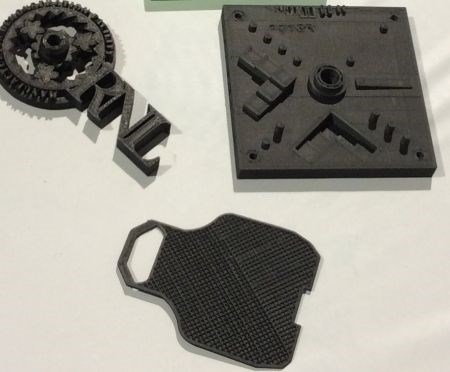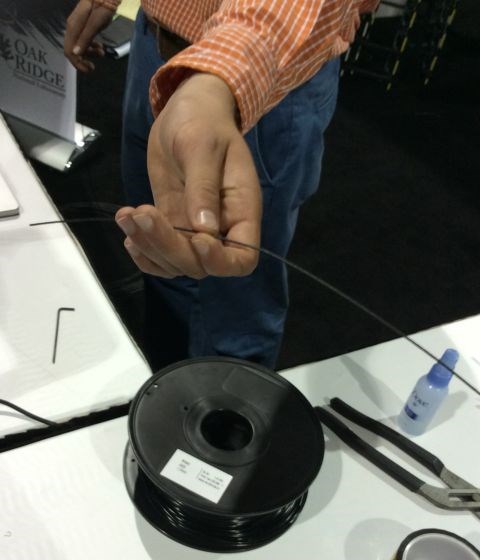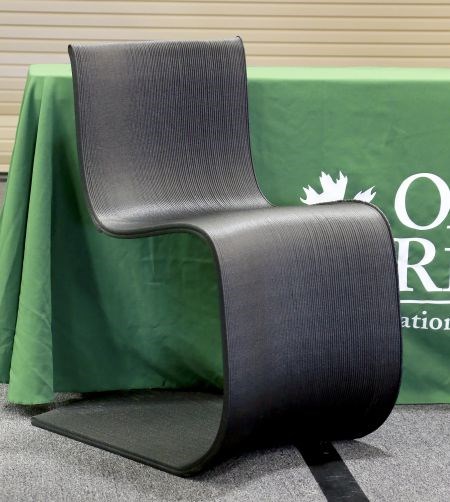ORNL demonstrates 3-D printing with carbon fiber
Oak Ridge National Laboratory can print carbon fiber reinforced parts from 10 cm in size up to 2.4m in both lab and production settings at its Carbon Fiber Technology Facility.

ORNL printed several small (10 cm) parts during its live demonstration
at the JEC Americas show. SOURCE: CompositesWorld
Oak Ridge National Laboratory (ORNL, Knoxville, Tenn.) demonstrated its 3-D printing capability using discontinuous carbon fiber live on the exhibit floor at the recent JEC Americas show (May 13-15, 2014, Atlanta, Ga., USA).
The single head printer uses fused deposition modeling (FDM) with fine carbon filaments, roughly 6 to 7 microns (micrometers) in diameter. (Human hair is approximately 50 micometers in diameter.)
FDM is a common type of 3-D printing in which molten thermoplastic materials are sequentially deposited in a digitally determined pattern to form a part. These parts are typically used only for prototyping because they lack structural properties. ORNL has worked to introduce carbon fiber into polymeric materials for 3-D printing to improve strength and stiffness of printed parts. ORNL can can produce carbon fibers in both laboratory and production settings at its Carbon Fiber Technology Facility (CFTF), which allows it to use alternative precursors, modify fiber properties and apply custom surface treatments and sizings compatible with FDM materials and processes.
Using discontinuous carbon filaments prevents issues with starting and stopping of the print head and allows production of parts with complex geometry. The filaments are combined into a polymeric matrix and the feedstock is prepared for FDM.

ORNL Manufacturing Demonstration Facility feedstock for FDM.
SOURCE: CompositesWorld
ORNL can use a wide variety of polymer matrices including acrylonitrile butadiene styrene (ABS), polylactic acid (PLA), and nylon. The print head can also be modified to accommodate higher performance matrices like polyetherimide (PEI) and polyetheretherketone (PEEK). Through work conducted at the U.S. Dept. of Energy's Manufacturing Demonstration Facility, ORNL has demonstrated that incorporating carbon filaments into the FDM process results in parts with 5 to 6 times the stiffness of unreinforced polymer and improves dimensional stability as well.
ORNL printed several small parts (10 cm) at the show (top photo) but also displayed a full-size chair which it printed with a large machine capable of producing objects over 2.4 m in any dimension.

Full-size carbon fiber chair printed by ORNL Manufacturing Demonstration Facility.
SOURCE: Oak Ridge National Laboratory
Related Content
-
MFFD longitudinal seams welded, world's largest CFRTP fuselage successfully completed
Fraunhofer IFAM and partners have completed left and right welds connecting the upper and lower fuselage halves and sent the 8×4-meter full-scale section to ZAL for integration with a cabin crown module and testing.
-
“Structured air” TPS safeguards composite structures
Powered by an 85% air/15% pure polyimide aerogel, Blueshift’s novel material system protects structures during transient thermal events from -200°C to beyond 2400°C for rockets, battery boxes and more.
-
Combining multifunctional thermoplastic composites, additive manufacturing for next-gen airframe structures
The DOMMINIO project combines AFP with 3D printed gyroid cores, embedded SHM sensors and smart materials for induction-driven disassembly of parts at end of life.














